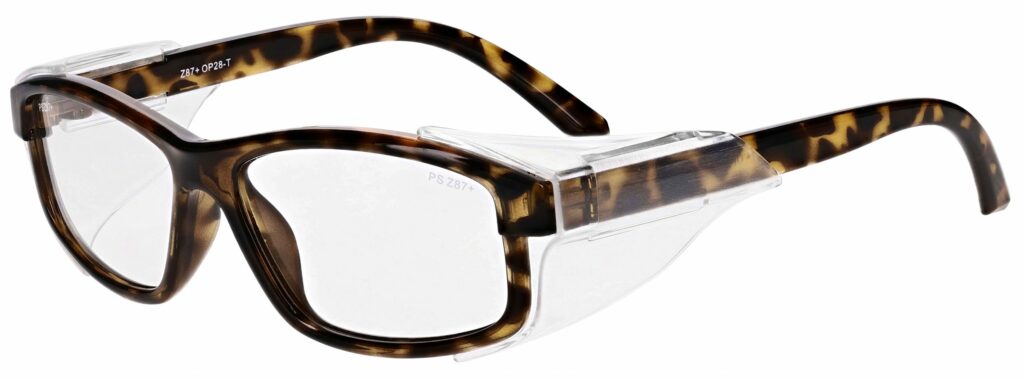Menu
Winter Sale
10% OFF Entire Store (T&C’s apply)
Use Code: WNTR23
Ends: 20/01/23, 11:59 pm GMT
Valentine’s Day
10% OFF Entire Store
Use Code: LUV23
Ends: 16/02/2023, 11:59 pm GMT
Winter Sale
10% OFF Entire Store (T&C’s apply)
Use Code: WNTR23
Ends: 20/01/23, 11:59 pm GMT
Valentine’s Day
10% OFF Entire Store
Use Code: LUV23
Ends: 16/02/2023, 11:59 pm GMT

Safety glasses and regular glasses are different – there’s no doubts to be had there. But what exactly are these differences, and just what about them should influence your decision in whether or not to invest in prescription safety glasses?
There are certain standards that must be met when considering the definition of just about anything. If it looks like a penguin and acts like a penguin – chances are, it’s probably a penguin. With safety glasses, these standards have to do with the level of offered resistance, and how it compares to that of regular glasses.
Most prescription glasses don’t meet this standard level of resistance that safety glasses offer – resistances to impact being the primary factor. Safety glasses are designed to live up to their name of safety in protecting your eyes.
The trouble with these can be the impairment of vision – you wear prescription glasses in order to fix your vision, but the majority of standard safety glasses don’t offer this same service. As of late, this has changed as prescription safety glasses, goggles and lab specs have been developed over time – differing from regular glasses in their higher impact resistance alone.
Safety glasses need to be tested before they’re released for use, and for a pair of safety glasses that have gone through assessment and been approved, you’ll be likely to find a stamp with EN166 (if you are in Europe) or ANSI (if you are in the USA). This is typically stamped on to the temple arm of the glasses.
The same goes for prescription safety glasses of course. There are plenty of other symbols that may appear on safety glasses, all of which have their own individual meanings. Such as the ‘F’ symbol, which indicates that the safety glasses frames have Low Energy Impact (45m/sec) Grade 2. An ‘S’ symbol may, on the other hand, indicate that the lenses have Increased Robustness (General Purpose).
Another way in which safety glasses differ from regular glasses is in the test. The high-impact tests may come off as over-the-top, but it’s all a part of making sure that the safety glasses are in fact worthy of the ‘safety’ part of their name.
The high-mass impact test involves using a steel projectile, one inch in diameter, dropped onto a frame-mounted safety lens from a height of at least 50 inches up. The projectile will typically weigh 17.6 ounces (or nearly 500 grams). In order for the safety glasses to be considered a pass, there are certain conditions that must be met: the lens must be fully retained by the frame that holds it, and all pieces must be fully attached within the frame component.
Another of the conditions is the high velocity impact test which is similar to the high-mass impact test, in the sense that it involves the use of a steel projectile. However, this one is a quarter-inches, and is shot at the lens from a distance of less than 10 inches at a velocity of 150 feet (45 meters) per second. The test is repeated a number of times in order to ensure the results are the same for every angle, and the passing conditions are the same as the high-mass impact test.
The last of the tests are perhaps the simplest, and they involve a durability test to be had. In these tests, rather than assessing impact to the lenses, their resistance to both flammability and to corrosion are tested. After all, safety glasses are worn in all kinds of environments, from the workplace to the science labs, and even on the average day-to-day for some! It’s important that all environments are thoroughly experimented with when discussing safety glasses.
Regular prescription glasses are simple enough to pick out – you can go into any opticians and pick out whichever pair you feel suit you best. But when it comes to picking out safety glasses, their effectiveness will often vary depending on where and how they’re needed.
For home use, or for casual wear, you needn’t always look into prescription safety glasses – often times, wearing contact lenses beneath your safety glasses can be just as effective and convenient. The prescription ones can be bought from us here at Safety Protection Glasses . An optician would need to assess your sight first in order to determines what kinds of lenses you may need. These home/casual safety glasses are often made using lightweight polycarbonate for the sake of comfort and convenience, and often come in more style options than your average safety glasses.
When discussing safety glasses for work purposes then the options tend to be widely different. Working in a lab, you may need regular safety lab goggles, but working in carpentry you may require a different kind altogether. It’s important that you look into it and ask with specialists in order to determine what types and models of safety glasses would best suit you at your place of work.
It can’t be said that safety glasses are a bad replacement for your regular prescription specs – after all, with more and more people looking towards prescription safety glasses for every day and casual use, it may be a bad idea not to invest.
Safety glasses offer all of the same effects that come with your regular glasses, only with an added bit of protection that your eyes may one day thank you for – after all, be it at work, or at home, you can never tell when something’s going to go flying. Less so where it’s going to land.
About Us
